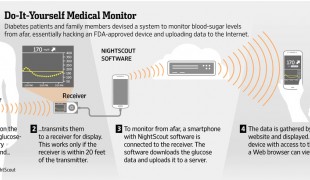- 6189
- 272
- 7
- 5
- 1
- Help Ukraine
About the solution
Type 1 diabetes (T1D) is a devastating chronic disease that is estimated to affect 80 000 new children each year. This disease is characterised by an impairment on the production of insulin by the pancreas, resulting in high levels of blood glucose levels in the body.
When Vivienne’s son, Felix, was diagnosed with T1D, she and her wife, Norma, were confronted with the blood glucose levels monitoring reality. More than monitoring Felix’s glucose levels, the two scientist started recording everything, including food intake, activity levels, emotional states and every blood glucose levels. In addition to this, they even built a small cyborg containing Fitbits, Basis Bands, wireless insulin pumps and continuous glucose monitors. If these wasn’t enough, they also had to hack the data captured by the wearable devices as it was not accessible. When Vivienne and Norma took all these information to the doctors, the reaction was not what they expected.
“It was truly crazy that my son was wearing an entire wardrobe of sophisticated technology, yet his pump would be set by hand once every few months based largely on intuition.”, said Vivienne.
Immediately, Vivienne began building an algorithm that evolved into Jitterbug, a new machine learning system, that was able not only to monitor but also to predict Felix’s glucose levels. As she wasn’t able to commercialize it, she donated all the codes and data to the TidePool Foundation, a nonprofit building open source code for diabetes.
“Every parent in the world should have that one moment where they feel like they have uniquely added something profound to the story of their child’s life.”, Vivienne said.
Adapted from: http://quantifiedself.com/2018/08/women-taking-control-vivienne-ming/
More info: https://su.org/about/faculty/vivienne-ming/
https://vimeo.com/81272562
This solution shall not include mention to the use of drugs, chemicals or biologicals (including food); invasive devices; offensive, commercial or inherently dangerous content. This solution was not medically validated. Proceed with caution! If you have any doubts, please consult with a health professional.
DISCLAIMER: This story was written by someone who is not the author of the solution, therefore please be advised that, although it was written with the utmost respect for the innovation and the innovator, there can be some incorrect statements. If you find any errors please contact the patient Innovation team via info@patient-innovation.com
-
-
448
-
0
-
12603

Nightscout – an open source, do-it-yourself continuous glucose monitor in the Cloud
Type 1 diabetes mellitus
Diabetes insipidus
Diabetes mellitus
Diabetes mellitus (incl subtypes)
Diabetes mellitus inadequate control
Fulminant type 1 diabetes mellitus
Cystic fibrosis related diabetes
Gestational diabetes
Insulin-requiring type 2 diabetes mellitus
Latent autoimmune diabetes in adults
Diabetes with hyperosmolarity
Diabetes complicating pregnancy
Insulin resistant diabetes
Type 2 diabetes mellitus
Type 3 diabetes mellitus
Pancreatogenous diabetes
Glucose metabolism disorders (incl diabetes mellitus)
Nephrogenic diabetes insipidus
Acquired lipoatrophic diabetes
Congenital central diabetes insipidus
Hyperglycaemia
Carbohydrate metabolism disorder
Inborn errors of carbohydrate metabolism (excl glucose)
Pancreas
Mobile app
Software
Insulin injector
Insulin pen
Insulin injection
Diabetes mellitus management
-
-
-
305
-
1
-
11086

Girl creates low-cost home dialysis machine
Diabetes insipidus
Diabetes mellitus
Diabetes mellitus (incl subtypes)
Glomerulonephritis
Kidney enlargement
Glomerulonephritis acute
Glomerulonephritis chronic
Chronic renal failure
chronic kidney failure
Kidney
electronic device
Haemodialyzer
Urination
Oedema peripheral
Localised oedema
Oliguria
Anuria
Dialysis
Dialysis device insertion
Haemodialysis
Peritoneal dialysis
-
-
-
433
-
0
-
10536

I-Port™ – Medication delivery device
Type 1 diabetes mellitus
Diabetes complicating pregnancy
Diabetes mellitus
Diabetes mellitus (incl subtypes)
Diabetes mellitus inadequate control
Latent autoimmune diabetes in adults
Insulin resistant diabetes
Insulin-requiring type 2 diabetes mellitus
Pancreatogenous diabetes
Type 2 diabetes mellitus
Type 3 diabetes mellitus
Gestational diabetes
Glucose metabolism disorders (incl diabetes mellitus)
Crohn's disease
Rheumatoid arthritis
Hypopituitarism
Dwarfism
Autoimmune disorders
Coagulopathy
Pancreas
Pituitary gland
Auto-injector
Insulin injector
Insulin pen
Insulin injection
Skin and subcutaneous tissue therapeutic procedures
Anticoagulant therapy
-
 en
en
aliceanner • Fri, 10/18/2019 - 10:44
I find the sharing helpful, I read a book about it here : thelostwaysreview.net